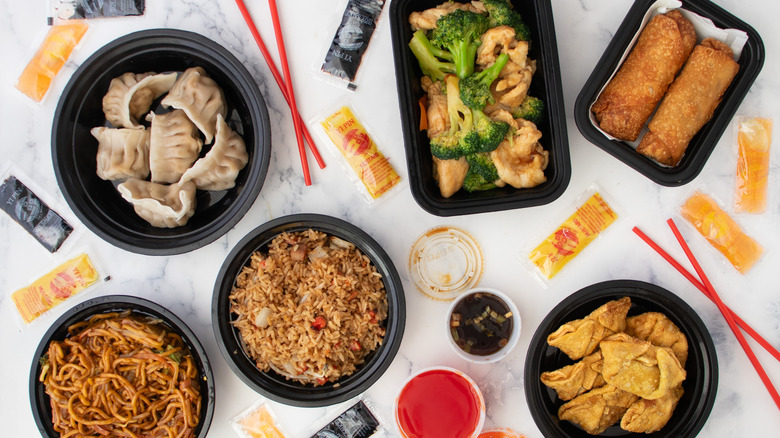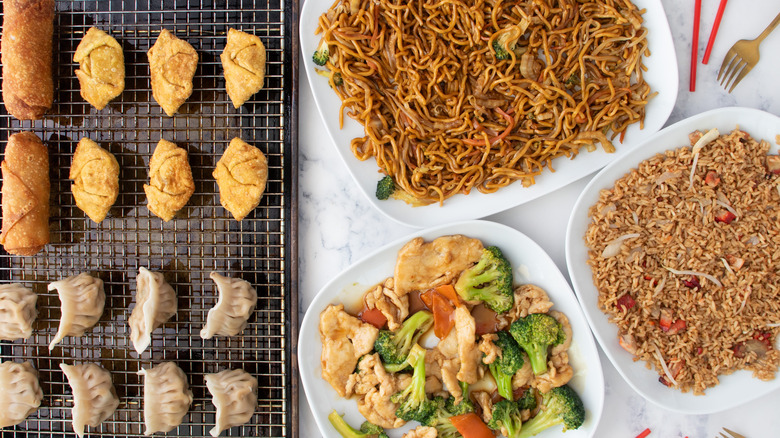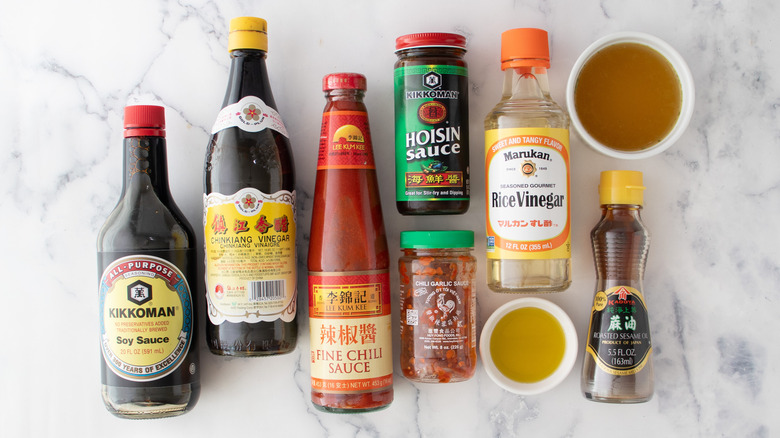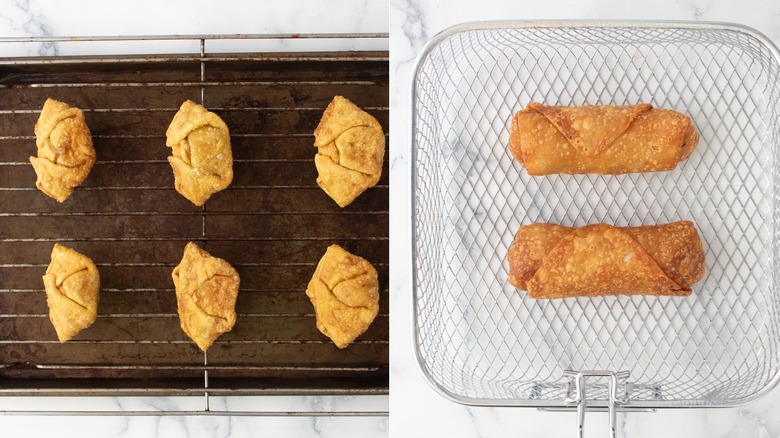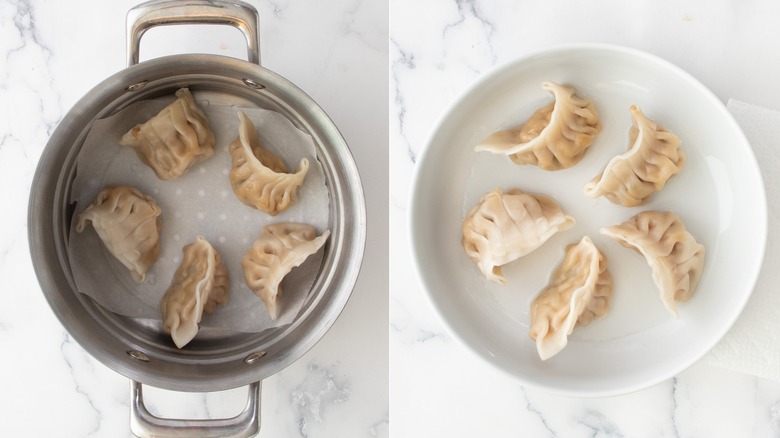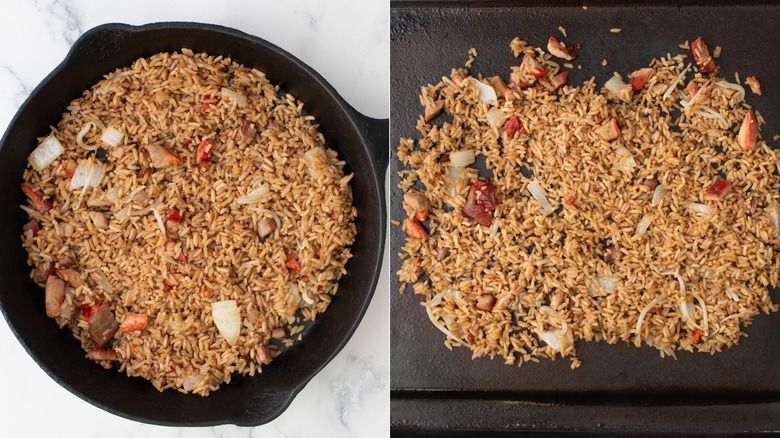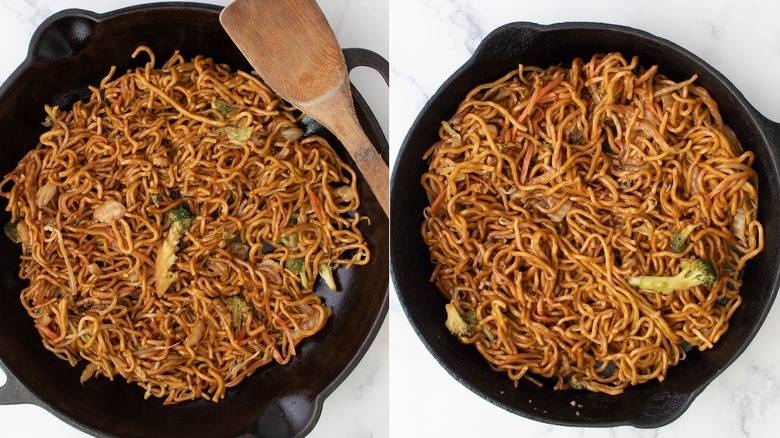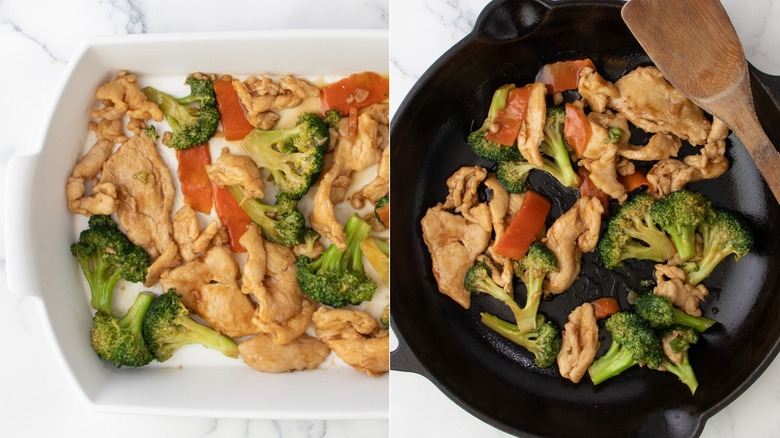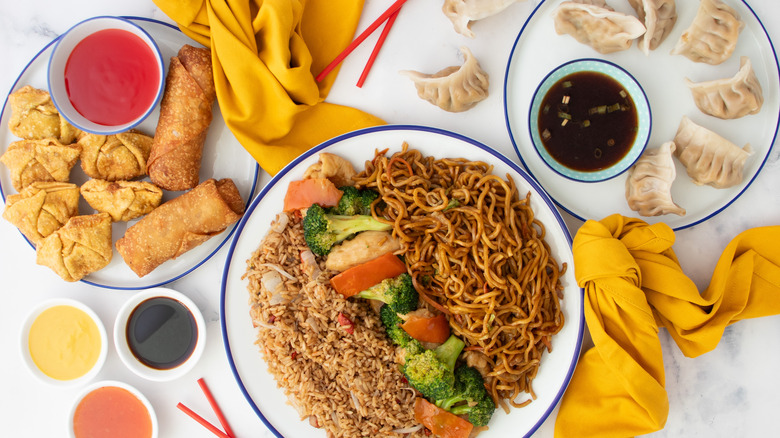How To Reheat Chinese Food For First-Bite Flavor
I don't know about you, but I am always guilty of over-ordering Chinese food. When fried rice and lo mein are involved, my eyes are almost always bigger than my stomach. Years of experience handling copious quantities of Chinese food leftovers, coupled with years of experience as a professional chef, makes me a uniquely qualified "expert leftover reheater." (Come to think of it, I should probably add that qualification to my LinkedIn profile). I always strive for recreating that first-bite flavor when it comes to reviving my leftovers.
In this article, we will tackle reheating all the Chinese food classics: crispy appetizers, steamed dumplings, rice dishes, noodle dishes, and stir-fried entrees. I'll take you through my preferred cooking methods, including sautéing, stir-frying, air-frying, baking, steaming, and microwaving. We'll also discuss the ingredients I use to revive my leftovers, as well as my top tips on storing your leftovers for a more successful reheat. Your Chinese takeout doesn't end when the meal is done — if you reheat things properly, it's just the beginning!
Prepping leftovers for a more successful reheat
You've ordered. You've eaten. You're absolutely stuffed. But before you close up those containers and stick them in the fridge, let's prep those leftovers! You'll thank me later.
There's a culinary term I want to introduce you to: carryover cooking. It means that even when removed from the heat source, the residual heat will continue to cook the food. Takeout containers are designed to lock in heat, keeping the food compact and toasty for the long ride between the restaurant and your house. To slow the carryover cooking process, we need to cool our leftovers quickly. First, at room temperature and then, on to the refrigerator.
For fried menu items (egg rolls, crab rangoon, etc.) and steamed appetizers (steam buns, dumplings, etc.), remove them from their containers and place on a wire rack, making sure to give each some breathing room for the air to freely circulate and cool. Once the items are cool to the touch, about after about 15-20 minutes, transfer them to a paper towel-lined plate, loosely wrap, and place in the refrigerator.
For rice, noodles, entrees, and side dishes, remove each from their container, and spread out evenly on a large plate or platter. Set aside to cool, uncovered, at room temperature for 15-20 minutes, or until cool to the touch. You can return the cooled items to their respective to-go containers or wrap the plates or platters with plastic and place in the refrigerator.
Reviving ingredients for first-bite flavor
As our Chinese food leftovers cool, their flavors can change with time. Sometimes the flavors improve and deepen, sometimes they mellow or become bland. The textures can change as well, either drying out (this can happen sometimes with fried rice) or becoming soggy (can happen with noodles or tender vegetables like broccoli, snow peas, bell peppers, etc.). To combat these changes, we will need some reviving ingredients to bring back those first-bite flavors and textures.
Sesame oil — used as a finishing oil, imparting rich sesame flavor and roasty aromatics.
Vegetable or peanut oil — these high-heat oils will be what we use for stove-top reheating.
Soy sauce or low sodium soy sauce — we will use soy sauce to replace any sodium loss, or reduction of salty flavor.
Vegetable, chicken, or beef broth — broths are an excellent way to rehydrate dried-out ingredients.
Chili garlic sauce or sriracha — spicy condiments can easily revive flavor, livening up our taste buds as well as the ingredients.
Rice wine vinegar or black vinegar — a splash or two of vinegar will replenish any loss of acidity.
Hoisin sauce or oyster sauce — these condiments are often used to season saucy, stir-fried dishes.
Reheating crispy appetizers
You can easily revive crispy appetizers using either the oven or air fryer.
For oven reheating, place appetizers on a wire rack-lined baking sheet, spreading out evenly, and without overlapping. Let the appetizers come to room temperature before placing them in a 400 F preheated oven. Bake for approximately 12-15 minutes (depending on the size) and until the internal temperature reaches 165 F.
For air fryer reheating, place the appetizers in a single layer in the basket, and let the appetizers come to room temperature. Preheat the air fryer to 375 F, insert the basket, and cook for 3-5 minutes, flipping halfway or until crisp and cooked through (165 F internal temperature).
You can revive your dipping sauces too, if necessary. Use a combination of soy sauce, vinegar (black or rice), and a little dollop of either chili garlic sauce or sriracha.
Reheating steamed dumplings
You can revive steamed dumplings using either the microwave or stove-top steamer.
For reheating in the microwave, place dumplings in a shallow, microwave-safe bowl, making sure the dumplings are not touching each other. Add 2 tablespoons of water to the bowl and cover with a damp paper towel. Place in the microwave and reheat in 30 second increments until hot and tender.
For reheating dumplings in a stove-top steamer, place a small sheet of parchment paper in the bottom of the steamer basket. Lightly spritz the parchment paper and any exposed basket with cooking spray and add the dumplings (again, keeping them separated to prevent sticking). Fill the bottom pot with the recommended amount of water and bring to a boil. Once boiling, reduce heat to medium-low, and add the dumpling-filled basket. Cover and steam for 5-10 minutes or until the dumplings are hot and tender.
Revive dipping sauces, if necessary, using a combination of soy sauce, vinegar (black or rice), and a little dollop of either chili garlic sauce or sriracha.
Reheating rice dishes
Leftover fried rice is best reheated using either a large skillet or griddle.
For reheating using a skillet, drizzle the pan with high-heat cooking oil, and preheat over medium-high. Once hot, add the fried rice, spreading out in an even layer, and cook, uncovered, for 2 minutes. Stir the fried rice, then cover the skillet with a lid or aluminum foil, and cook for another 2-3 minutes or until hot throughout. If your fried rice is really dry, add a tablespoon of broth to the pan before covering. Before removing the rice from the skillet, season with a dash of soy sauce, to taste.
For reheating using a griddle, preheat the griddle over medium-high heat. Drizzle with a little high heat cooking oil and, once hot, add the fried rice, spreading out in an even layer. Cook for 2 minutes, undisturbed, then drizzle the rice with a tablespoon of broth. Stir and continue to cook for 2 minutes or until hot throughout. Before removing from the griddle, season with a dash of soy sauce, to taste.
Reheating noodle dishes
Noodles dishes, like lo mein, are best reheated using either a large skillet or wok.
To reheat using either a skillet or wok, drizzle the pan with high-heat cooking oil, and preheat over medium-high. Once hot, add the noodles, and stir-fry for 3 minutes. Season the noodles with a dash of vinegar, a dash of broth, and a small dollop of oyster sauce or hoisin, toss to coat. Cook for 1 minute more, give the noodles a quick taste, and add any additional vinegar, broth, or oyster sauce to adjust. Make sure your reheated noodles are hot throughout before serving.
If your noodles are packed with tender vegetables (broccoli, snow peas, snap peas, etc.), you might want to remove them from the mix, setting aside until the final minute or so of the reheat. This way you don't run the risk of overcooking those tasty veggies!
Reheating stir-fried entrees
There's a trio of ways to successfully reheat these stir-fried leftovers; large skillet, wok, or in the oven.
To reheat using either a skillet or wok, pour a little broth into the bottom of the pan along with a dollop of oyster sauce or hoisin, and bring to a simmer over medium-high heat. Once simmering, add the leftovers, and sauté or stir-fry for 3 minutes or until hot throughout. Before removing your reheated leftovers from the pan, drizzle with a tiny bit of sesame oil and add a drop or two of sriracha or chili garlic sauce (if you like things a little spicy).
To reheat your leftovers in the oven (an excellent reheating method if you have a large quantity of leftovers), lightly spritz a baking sheet or casserole dish with cooking spray. Add your leftovers, spreading out in an even layer. Place a little broth and oyster sauce or hoisin in a small bowl, and whisk to combine. Pour the mixture over your leftovers, cover with aluminum foil, and place in a 350 F preheated oven. Cook for 15 minutes, stirring halfway through, or until hot throughout. Before serving, drizzle with a tiny bit of sesame oil and add a drop or two of sriracha or chili garlic sauce.
Getting creative with your Chinese takeout leftovers
If you are interested in remixing your leftovers into entirely new meals or other creative uses for leftover Chinese takeout, there are a few personal favorites I like turning to. I often make an omelet using leftover fried rice as the filling, omurice style. I especially like adding a slice or two of American cheese inside the omelet and a hearty drizzle of yum-yum sauce or ketchup to the top. Delicious!
Leftover beefy stir fries (pepper steak, Szechuan beef or Mongolian beef) make for especially tasty quesadillas or super-charged grilled cheeses. Kung pao chicken, Szechuan chicken, or spicier stir-fried chicken (without a lot of vegetable additions) are all excellent options for Asian-inspired nachos or tacos. These protein heavy, chicken-based leftovers are great in lettuce wraps too.
Leftover, plain white rice is great for making rice-based soups or stews. I love a good chicken and rice soup using leftover, take-out white rice. If you are a fan of congee, leftover white rice works really well as a base.
As a safety reminder, whether you are reheating for first-bite flavor or remixing into new and exciting dishes, be sure to consume your leftovers within 3 to 4 days. Make sure to refrigerate your leftovers after briefly cooling them at room temperature. And, reheat to above the temperature danger zone (140°F plus).
